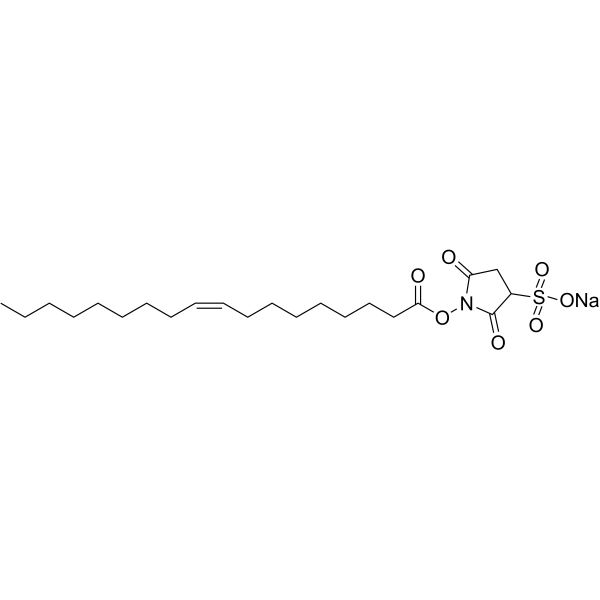
Sulfosuccinimidyl oleate sodium
CAS No. 1212012-37-7
Sulfosuccinimidyl oleate sodium( Sulfo-N-succinimidyl oleate sodium )
Catalog No. M26470 CAS No. 1212012-37-7
Sulfosuccinimidyl oleate sodium is a long-chain fatty acid that inhibits the transport of fatty acids to cells. Sulfosuccinimidyl oleate sodium is an effective, irreversible inhibitor of mitochondrial respiratory chain. Sulfosuccinimidyl oleate sodium binds to CD36 receptors on the surface of microglia.
Purity : >98% (HPLC)
 COA
COA
 Datasheet
Datasheet
 HNMR
HNMR
 HPLC
HPLC
 MSDS
MSDS
 Handing Instructions
Handing Instructions
| Size | Price / USD | Stock | Quantity |
| 5MG | 59 | Get Quote |


|
| 10MG | 107 | Get Quote |


|
| 25MG | 177 | Get Quote |


|
| 50MG | 284 | Get Quote |


|
| 100MG | 447 | Get Quote |


|
| 200MG | 574 | Get Quote |


|
| 500MG | Get Quote | Get Quote |


|
| 1G | Get Quote | Get Quote |


|
Biological Information
-
Product NameSulfosuccinimidyl oleate sodium
-
NoteResearch use only, not for human use.
-
Brief DescriptionSulfosuccinimidyl oleate sodium is a long-chain fatty acid that inhibits the transport of fatty acids to cells. Sulfosuccinimidyl oleate sodium is an effective, irreversible inhibitor of mitochondrial respiratory chain. Sulfosuccinimidyl oleate sodium binds to CD36 receptors on the surface of microglia.
-
DescriptionSulfosuccinimidyl oleate sodium is a long-chain fatty acid that inhibits the transport of fatty acids to cells. Sulfosuccinimidyl oleate sodium is an effective, irreversible inhibitor of mitochondrial respiratory chain. Sulfosuccinimidyl oleate sodium binds to CD36 receptors on the surface of microglia.(In Vitro):Sulfosuccinimidyl oleate (50 μM, 24 hours) co-treatment significantly reduces the LPS+IFNγ-induced expression of NOS2 and COX-2 in BV2 cells. Western blot analysis reveals a significant LPS/IFNγ-induced upregulation in the phosphorylated form of the p38, which is prevented by co-treatment with Sulfosuccinimidyl oleate (50 μM, 24 hours).(In Vivo):In male BALB/cABom mice with pMCAo model, Sulfosuccinimidyl oleate (50 mg/kg; administered once by single oral gavage) significantly reduces the cortical ischemic infarct size compared to vehicle-treated controls. In addition, Sulfosuccinimidyl oleate(50 mg/kg) is suitable to see a beneficial effect after stroke.
-
In VitroCell Viability Assay Cell Line:BV2 cells Concentration:20 μM and 50 μM Incubation Time:24 hours Result:Did not alter the viability of BV2 cells alone. Exposure of BV2 cells to 100 ng/mL LPS and 5 ng/mL IFNγ significantly reduced the viability of BV2 cells while simultaneous treatment with Sulfosuccinimidyl oleate prevented it.Western Blot Analysis Cell Line:BV2 cells Concentration:50 μM Incubation Time:24 hours Result:Drastically increased the levels of NOS2, COX-2, and P-p38/T-p38.
-
In VivoAnimal Model:4-month-old male BALB/cABom mice with pMCAo model Dosage:50 mg/kg Administration:Administered once by single oral gavage Result:Reduced brain damage following ischemia. Attenuated infarct size.
-
SynonymsSulfo-N-succinimidyl oleate sodium
-
PathwayOthers
-
TargetOther Targets
-
Recptorinflammation
-
Research Area——
-
Indication——
Chemical Information
-
CAS Number1212012-37-7
-
Formula Weight481.58
-
Molecular FormulaC22H36NNaO7S
-
Purity>98% (HPLC)
-
SolubilityIn Vitro:?DMSO : 62.5 mg/mL (129.78 mM)
-
SMILESO=S(C(C1)C(N(OC(CCCCCCC/C=C\CCCCCCCC)=O)C1=O)=O)(O[Na])=O
-
Chemical Name——
Shipping & Storage Information
-
Storage(-20℃)
-
ShippingWith Ice Pack
-
Stability≥ 2 years
Reference
1.Kohno K, Ohashi E, et al. Anti-inflammatory effects of adenosine N1-oxide. J Inflamm (Lond). 2015 Jan 20;12(1):2.
molnova catalog



related products
-
ML297
ML297 is a selective Kir3.1/3.2 (GIRK1/2) channel activator (IC50 values are 160, 887 and 914 nM for GIRK1/2, GIRK1/4 and GIRK1/3 respectively).
-
Methyl 3-hydroxynona...
Methyl 3-hydroxynonanoate is a fatty acid.
-
cAC 253
Amylin (AMY3) antagonist (IC50 = 0.3 μM). Protects neuronal cells from Aβ(1-42)-induced cytotoxicity in vitro. Brain penetrant. Improves spatial memory and reduces Aβ plaque number and total area in a mouse Alzheimer's disease model.



 Cart
Cart
 sales@molnova.com
sales@molnova.com


